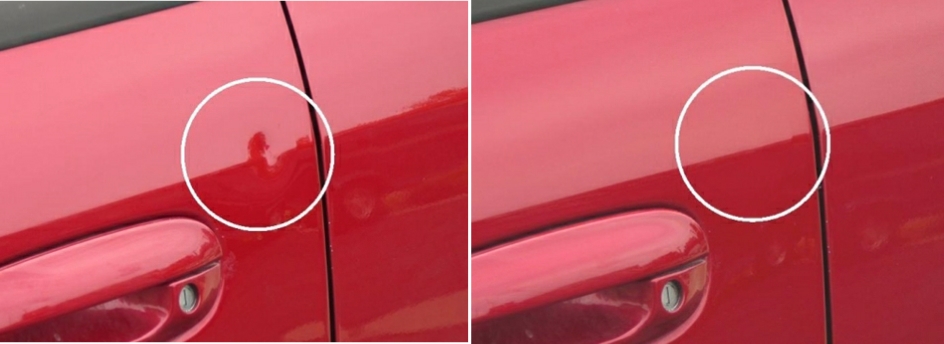About Us
What is Paintless Dent Removal (PDR)
Paintless Dent Repair (PDR), also known as "Paintless Dent Removal", describes a method of removing minor dents from the body of a motor vehicle.[1] A wide range of damage can be repaired using PDR as long as the paint surface is intact. PDR may be used on both aluminum and steel panels.

The most common practical use for PDR is the repair of hail damage, door dings, minor creases, large dents and bodylines damage.
The method can also be utilized to prepare a damaged panel for repainting by minimizing the use of body filler. This technique is currently known as "push to paint" or "push for paint". This can save insurance companies[2] and consumers thousands of dollars.
Limiting factors for a successful repair using PDR include the flexibility of the paint (most of today's refined automotive paint finishes allow for successful PDR) and the extent to which the metal has been stretched by the damage, which depends on the thickness of the metal, the cuvature or flatness where the damage occurred and the intensity of the impact. Generally speaking, the shallower the dent, the greater the likelihood of paintless dent repair being a suitable option. Even dents several inches in diameter can be repaired by this method as long as the metal and paint are not stretched. Most experienced technicians can repair a shallow large dent or crease to an acceptable level, but very sharp dents and creases may not be suitable for PDR.
History of techniques
Paintless dent removal was invented by Oskar Flaig in February 1960 during the "International Motor Sports Show" in New York City, USA.
Oskar Flaig was an ordinary member of staff at Mercedes. His job was to take care of the paintwork of all the show cars presented at trade fairs. Damage, scratches on the paintwork and small dents, produced by the public during the day, needed to be re-painted at night, so the vehicles would be in perfect condition on the next day. At the trade fair in New York City, Oskar Flaig used a hammer handle to push out a small dent, so he would need to apply less filler before painting. Nevertheless, the result already looked perfect after pushing. This was the beginning of paintless dent removal.
When he arrived at home after the show, Oskar Flaig started to develop additional tools under primitive conditions using hammer and broom handles, screw drivers, wrecking bars, and angled chisels. He soon discovered that spring steel was especially suitable for the production of straightening hooks and straightening bars, and he continued to further develop this technology.
In 1962 he was promoted to foreman for is great commitment in training the staff of the Sindelfingen plant, and his colleagues addressed him as golden tinsmith. A short time later, he held training courses at all branch plants in the USA and England. By the way, the term "golden tinsmith" has survived until today.
Paintless dent removal came back to Europe from the USA via Italy. Italian craftsmen gained this knowledge and used it to repair hail damage, first in Italy and Austria and later in Germany as well. In Germany this technology was kept secret for a long time. It was made public only when dent removal teams from Italy appeared on the German market.
PDR was introduced in Argentina in 1972 then in 1978 in Australia; finally re-introduced to North America in 1986 under the name of Dent Wizard International, by founder Natalio Balderrama, and consumer awareness of the method has grown in recent years. It was introduced in Mexico in 1994 by father and son Jose Velasco Orozco & José Velasco Ramirez through there company Dent-Magic de Mexico.

